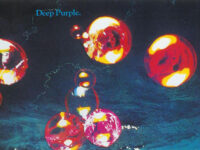Keyboardist Jon Lord, a key element of the Deep Purple sound and co-writer of their signature track “Smoke on the Water,” has died at 71. He had battled pancreatic cancer since a diagnosis last August.
Lord recently announced a new album and a return to the stage set for early this month, but was forced to postpone the scheduled show. His publicist issued the statement confirming Lord’s death today following a pulmonary embolism at a London clinic, surrounded by his family.
Many fans had hoped that the scheduled appearance in Germany signaled a rebound for Lord. He’d been aimingto present a special performance of 2008’s Durham Concerto on July 6, 2012, in Hagen, Germany. Edel in Germany and ABC Records in Australia are apparently moving ahead, though, with plans to issue Concerto for Group and Orchestra, a hour-long, three-movement piece recorded at the legendary Abbey Road Studios with Liverpool’s Philharmonic.
Lord co-founded Deep Purple in 1968, and remained with the band through its initial breakup 1976. He then returned again from 1984-2002, before retiring from the group — one of the early pioneers in heavy progressive rock. ‘We’re as valid as anything by Beethoven,” Lord said of Deep Purple, in an interview with the New Musical Express from 1973.
In the intervening years, Lord also joined Whitesnake, fronted by Deep Purple’s most recent lead singer David Coverdale. The keyboardist, who played with a classically inspired bravado on tracks like “Child in Time” and had been classically trained beginning at the age of 5, was also in the offshoot group Paice Ashton and Lord, with fellow Deep Purple member Ian Paice. An early band, called Santa Barbara Machine Head, also featured Ronnie Wood, who’d later become best known as a member of the Rolling Stones.
It was Paice who initially confirmed Lord’s cancer diagnosis for the media — though, back then, he was more optimistic about a recovery: “There are no more cancer cells being produced,” Paice said, “and those that are lying dormant are being, hopefully, wiped out as we speak by a brand new treatment which he is over in Israel having right now. So we’re already thinking that he may be back working in April or May.”
Deep Purple fans will remember Lord’s Concerto for Group and Orchestra from the classic rock band’s 2000-01 world tour. It was something of a touchstone piece for Lord, who began work on the classically inspired piece in 1969 and eventually performed it on some 100 different occasions. The latest iteration includes appearances by Deep Purple guitarist Steve Morse, as well as Joe Bonamassa, Steve Balsamo, Kasia Laska, and Bruce Dickinson of Iron Maiden. Ian Gillan, another of Lord’s longtime bandmates in Deep Purple, contributed lyrics.
[amazon_enhanced asin=”B00008HCB7″ container=”” container_class=”” price=”All” background_color=”FFFFFF” link_color=”000000″ text_color=”0000FF” /] [amazon_enhanced asin=”B000002KHB” container=”” container_class=”” price=”All” background_color=”FFFFFF” link_color=”000000″ text_color=”0000FF” /] [amazon_enhanced asin=”B0016RTUVG” container=”” container_class=”” price=”All” background_color=”FFFFFF” link_color=”000000″ text_color=”0000FF” /] [amazon_enhanced asin=”B00004SWDU” container=”” container_class=”” price=”All” background_color=”FFFFFF” link_color=”000000″ text_color=”0000FF” /] [amazon_enhanced asin=”B000ZOWOCS” container=”” container_class=”” price=”All” background_color=”FFFFFF” link_color=”000000″ text_color=”0000FF” /]
Here’s a look back at our recent thoughts on Deep Purple. Click through the titles for complete reviews …
DEEP PURPLE – TOTAL ABANDON: AUSTRALIA ’99 (2012): An intriguingly presented retrospective set, as the newly added Steve Morse brilliantly reexamines a group of signature Deep Purple tunes. Before the show is over, Total Abandon recalls not so much the Ritchie Blackmore years as it does the band’s fiery Tommy Bolin period. There’s a similar level of front-line guitar craft, and a similar level of energy. Deep Purple sounded like it was having fun again. And, to my ears, the group never really looked back so intently again. By the time they issued Bananas, some five years later, original keyboardist Jon Lord was gone — and Deep Purple had metamorphosed. The addition of Morse, like an ozone-producing jolt of lightning, had transformed what once seemed like a ghost band trying to reclaim its glory days into a freshly rejuvenated force to be reckoned with.
DEEP PURPLE – SHADES OF DEEP PURPLE (1968; 2011 REISSUE): Coming together in 1967, Deep Purple were like a lot of bands of the day, as their mission was to push the sonic envelope as far as possible and create something new and exciting. Based out of Hertford, England, the group achieved their goal straight away. Dramatic and bombastic, Deep Purple played a tumultuous blend of heavy metal and progressive rock before such labels arrived into being, tagging them pioneers of the genres.
FORGOTTEN SERIES: EPISODE SIX – THE ROOTS OF DEEP PURPLE: THE COMPLETE EPISODE SIX (1994): Formed in the summer of 1964, Episode Six quickly developed a star-studded reputation as a hotshot live band. The English group, which included lead singer Ian Gillian and bassist Roger Glover, who eventually gleaned even more accolades in Deep Purple, also cut a flock of brilliant singles that are featured on this set, along with a brace of previously unreleased material.
- Ernesto Cervini’s Turboprop, “When I Fall” (2024): Video premiere - March 15, 2024
- Disaster Pony,“Dead Neon & The Noon Sun” from ‘Disaster Pony’ (2024): Video premiere - February 27, 2024
- Christopher Hoffman, “Farewell Forever” from ‘Vision Is The Identity’ (2024): Streaming premiere - February 19, 2024



